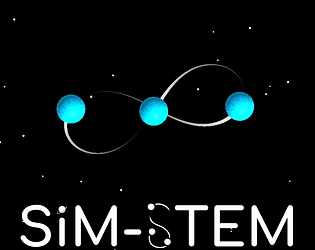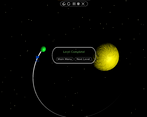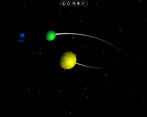I liked the idea very much. It was very relaxing and fun. It was hard at times to read the text in the middle, but I liked the atmospheric music very much. Good game!
Play game
SiM-STEM's itch.io pageResults
| Criteria | Rank | Score* | Raw Score |
| Fun | #956 | 3.333 | 3.333 |
| Overall | #1447 | 3.244 | 3.244 |
| Originality | #1594 | 3.333 | 3.333 |
| Presentation | #1875 | 3.067 | 3.067 |
Ranked from 30 ratings. Score is adjusted from raw score by the median number of ratings per game in the jam.
How does your game fit the theme?
Gravity binds the universe together, so now you must learn to work with it
Did your team create the vast majority of the art during the 48 hours?
We created the vast majority of the art during the game jam
Did your team create the vast majority of the music during the 48 hours?
We created the vast majority of the music during the game jam
Comments
I could sit and listen to that atmospheric music for hours... Such a unique and creative take on the theme. Really different from anything else I've played so far, worked a different side of my brain. A standout for sure. Great work!
Neat concept, always fun to play a space game.
Cool puzzles and really cool design and mechanics for the gravity. I would only tweak the tutorial a bit and mention that the mouse wheel can zoom in and out. I couldnt beat level two until I figure that out lol.
Good job
I feel like sometimes, planets aren't triggering the targets or the goals
Pretty cool game, definitely a unique concept.
I’m a sucker for physics simulation, and n-body problems are tricky in general, although here I guess you’re getting away with it by keeping the number of planets small (as in, not thousands or millions). I’m not sure how physically accurate this implementation is but it doesn’t seem too bad.
Anyway, I had fun playing it and it’s an interesting take on the theme, could use a bit more polish in terms of the UI and other visuals, but it’s alright for a jam game.
The main actionable criticism I’d give, then, is that in the beginning it wasn’t really clear what the green and blue markers were and what the win conditions were. The guide does sort of explain it but it doesn’t really tie the rules together with the actual visuals on screen, and there’s a bit of a disconnect there.
It would also be nice being able to position the objects and set their velocities with more granularity, perhaps with some tools to aid with precise alignment (e.g. getting three equal mass objects to orbit each other a third of a full circle apart from each other at the right kind of tangential velocity to get them to orbit in a stable manner, not super easy to do with the current grid-based solution)
Yeah one of my biggest regrets was not making checkpoints/goals clearer, especially since some require multiple bodies to hit them while others only need one. If i work on it in the future I'll definitely add a sort of start-of-level description like poly bridge has.
I hadn't considered alternatives to grid/non grid position/velocity snapping but it would be super cool if once you placed a body the velocity could snap into place (maybe by holding control or some other button) to the nearest velocity that establishes a stable orbit. And then maybe an alternative grid that is radial rather than rectangular with the origin at the current center of mass of the system, or a given selected body or bodies.
And since you seemed interested in the implementation, I used a method i found described here: https://en.wikipedia.org/wiki/Numerical_model_of_the_Solar_System#Integration, where it seems better than a standard leapfrog integration, but not as expensive as Runge-Kutta. I also calculate all the bodies' updated positions first and then update them all after so that symmetrical setups don't break as quickly.
So it’s basically using the midpoint method? I’m not sure if RK4 is particularly expensive but it’s a bit more of a pain to implement than these explicit methods. Implicit methods are nice though because they handle numerically stiff problems without exploding, and can usually do much larger step sizes.
In any case, you guys did a pretty good job with it =D
This is a really fun puzzle style! Seeing that it's actually grounded in some kind of orbital mechanics is cool too. I think some more planet-y graphics would help elevate this to a full-blown aesthetic as well, but gameplay itself is super fun!
Interesting game concept. Really liked the physics style puzzle based on orbit. Keep up the great work
Very nice! I enjoyed the puzzled and the soothing atmosphere. I wish it was clearer you were aloud to make planets go offscreen, and per my personal preference have a bit longer aim trajectory, at least for the dual planet ones. Besides those two gripes though I really liked it! Great work!
Really enjoyed the puzzles. They had a nice difficulty curve. Got crazy when you added two planets in there. Theme and art amazing also.
Really cool atmosphere! Interesting concept of using a type of gravity simulation to create orbits. nice work!
Cool game, I like the music and the gameplay very much. The UI could be improved, with the level finish showing up above the center planet making it hard to read, and some buttons that didnt seem to do anything when playing through the levels. It does remind me of the video by sebastian lague from his procedural planets, but the game is well done and good in its own regard.
I totally agree with you! I noticed the level finish text thing right before we uploaded but there wasn't enough to to fix it. If I ever go back to it the UI is definitely the fist thing I would tackle though (along with adding an actual tutorial). I also do love all of Sebastian Lague's coding adventures and definitely took some inspiration from them in terms of visuals for the simulation.
Hey! One of the devs here! In order to get the build working on Mac, follow these instructions:
- Navigate to the folder "Final Build Mac" where the game is located.
- Right-click in the finder window, and select "New Terminal at Folder"
- In the terminal, type "chmod -R +x *" to enable executable permissions.
- Right click on the app icon and click "Open" (simply double clicking doesn't work because Mac doesn't trust our game!)
And that should work!








Leave a comment
Log in with itch.io to leave a comment.